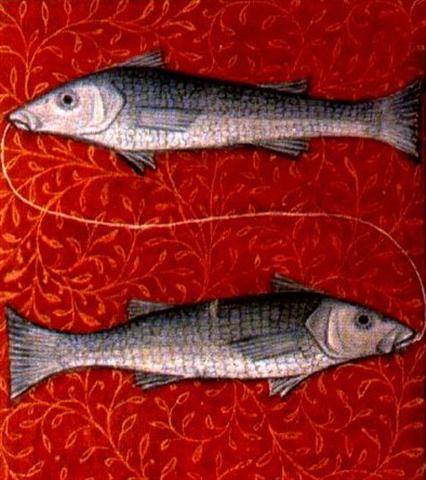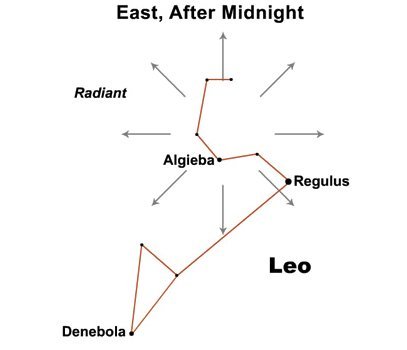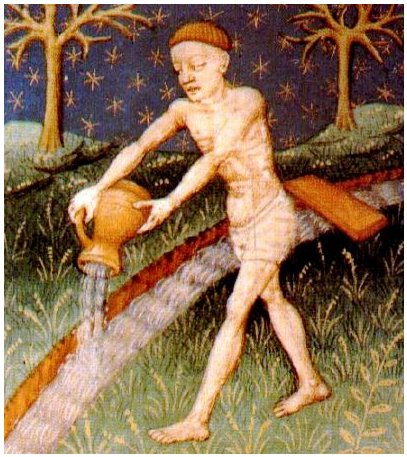Ba7.6
The theme of hanging victims
('fish', ika) - at Ba7-5--6 - was used also in other texts, and when
Metoro here said here (to fasten, to tie) it may have
alluded to the fate
of the pair of 'winter fishes' (Pisces), who eventually
had to be snared in
a trap at the knot star Al-risha (*29). The red spring
opening (vaha mea) should be followed by a full stop for
these fishes, because they represented the state of winter death
(cfr the expression 'go to the fishes').

I.e., Metoro may have thought the creator of the B text here had
illustrated Pisces as a pair of hanging fishes in order to
convey the idea of a knot as a reference to the knot star
Ukdah.
... They strung them through the heads with
sennit, and act called tu'i-aha, and then suspended them
upon the boughs of the trees of the seaside and inwards, the
fish diversifying the ghastly spectacle of the human bodies, a
decoration called ra'a nu'u a 'Oro-mata-'oa (sacredness
of the host of Warrior-of-long-face) ...

 |
 |
 |
 |
 |
 |
|
Ba6-44 |
Ba7-1 |
Ba7-2 |
Ba7-3 (250 + 4) |
Ba7-4 |
Ba7-5 |
|
e tagata hoko |
ki te kea e |
kua rere te manu ki ruga |
o te tagata - koia kua
vaha mea |
ko te tao kua mau - i te ika |
eko te tao - kua
here ki te ika |
|
Tao.
1. To cook in an oven, to sacrifice. P
Mgv., Mq., Ta.: tao, to cook in an oven. 2.
To carry away. 3. Abscess, bubo, scrofula, boil,
gangrene, ulcer, inflammation, sore. Mgv.:
taotaovere, small red spots showing the approach
of death. Mq.: toopuku, toopuu, boil,
wart, tumor. Ta.: taapu, taapuu,
scrofula on neck and chin. 4. Mgv.: a lance, spear.
Ta.: tao, id. Sa.: tao, id. Ma.:
tao, id. 5. Mgv.: taotaoama, a fish.
Sa.: taotaoama, id. 6. Ta.: taoa,
property, possessions. Ma.: taonga, property,
treasure. Churchill. Sa.: tao, to
bake; taofono, taona'i, to bake food
the day before it is used; tau, the leaves
used to cover an oven. To.: tao, to cook food
in a oven, to bake. Fu.: taò, to put in an
oven, to cook. Niuē:
tao, to
bake. Uvea: tao,
to cook, to bake. Ma., Rapanui: tao,
to bake or cook in a native oven, properly to steam,
to boil with steam. Ta.: tao,
the rocks and leaves with which a pig is covered
when cooking; baked, boiled, cooked. Mq., Mgv., Mg.,
Tongareva: tao,
to bake in an oven ... The word refers to the
specific manner of cookery which involves the pit
oven. The suggestion in the Maori, therefore, does
not mean a different method; it is but an attempt
more precisely to describe the kitchen method, a
very tasty cookery, be it said. The suggestion of
boiling is found only in Tahiti, yet in his
dictionary Bishop Jaussen does not record it under
the word bouillir;
boiling was little known to the Polynesians before
the European introduction of pottery and other
fire-resisting utensils ... Churchill 2.
Kao-kao, v. Haw.,
be red. Root and primary meaning obsolete in Haw.
Sam., tao,
to bake. Marqu., tao,
bake, roast, sacrifice. Tah., tao,
baked, boiled, cooked. Greek, καιω,
Old Att. καω,
to light, kindle, burn, scorch. According to Liddell
and Scott, Pott refers καιω
to Sanskrit çush,
be dry, but Curtius rejects this. In Dravid. (Tamil)
kay, to
be hot, burn. Fornander.
Here. 1. To catch eels in a snare of sliding
knots; pole used in this manner of fishing, with a
perforation for the line. 2. To tie, to fasten, to
lash; rasp made of a piece of obsidian with one
rough side; cable, tie; figuratively: pact,
treatise. Vanaga. 1. To lash, to belay, to knot the
end of a cord, to lace, to tie, to fasten, to knot;
to catch in a noose, to strangle, to garrote;
here pepe, to saddle; moa herea, a
trussed fowl; hehere, collar, necklet;
herega, bond, ligament; heregao, scarf,
cravat. 2. Hakahere. To buy, to sell, to
barter, to part with, to pay for, to do business, to
compensate, to owe, to disburse, to expiate, to
indemnify, to rent out, to hire, to traffic, to
bargain, to bribe; merchant, trader, business,
revenge; tagata hakahere, merchant, trader;
hakahere ki te ika, to avenge; hakaherega,
ransom, redemption; hakahererua, to exchange,
to avenge. 3. Here ei hoiho, incense.
Churchill. Hereke, festering wound, cracked
skin. Barthel 2. |
|
Febr 9 (40) |
10 |
11 |
12 (408) |
13 |
All Hearts' Day |
|
... On February 9
the Chorti Ah K'in, 'diviners', begin the
agricultural year. Both the 260-day cycle and the
solar year are used in setting dates for religious
and agricultural ceremonies, especially when those
rituals fall at the same time in both calendars. The
ceremony begins when the diviners go to a sacred
spring where they choose five stones with the proper
shape and color. These stones will mark the five
positions of the sacred cosmogram created by the
ritual. When the stones are brought back to the
ceremonial house, two diviners start the ritual by
placing the stones on a table in a careful pattern
that reproduces the schematic of the universe. At
the same time, helpers under the table replace last
year's diagram with the new one. They believe that
by placing the cosmic diagram under the base of God
at the center of the world they demonstrate that God
dominates the universe. The priests place the stones
in a very particular order. First the stone that
corresponds to the sun in the eastern, sunrise
position of summer solstice is set down; then the
stone corresponding to the western, sunset position
of the same solstice. This is followed by stones
representing the western, sunset position of the
winter solstice, then its eastern, sunrise position.
Together these four stones form a square. They sit
at the four corners of the square just as we saw in
the Creation story from the Classic period and in
the Popol Vuh. Finally, the center stone is placed
to form the ancient five-point sign modern
researchers called the quincunx
... |
|
DEC 7 |
8 |
9 |
10 (408 - 64) |
11 (345) |
12 |
|
STARS INVISIBLY
CLOSE TO THE SUN: |
|
BUNDA (THE
FOUNDATION) |
θ
Piscis Austrini (330.1),
λ
Oct.
(330.7) |
|
Al Sa'd al Su'ud-22 (Luckiest of the Lucky) /
Emptiness-11 (Rat)
TSIN = 36 Capricorni
(325.2),
ALPHIRK (The Flock) =
β
Cephei
(325.7),
SADALSUD =
β
Aquarii,
ξ
Gruis (325.9) |
No star listed (326) |
CASTRA = ε Capricorni (327.2),
BUNDA = ξ Aquarii
(327.5)
SIRIUS (α Canis Majoris) |
Mahar sha hi-na Shahū-26 (Western One in the Tail of
the Goat)
NASHIRA =
γ
Capricorni
(328.0),
ν
Oct. (328.3),
AZELFAFAGE =
π¹
Cygni,
κ
Capricorni (328.7) |
Arkat sha hi-na Shahū-27 (Eastern One in the Tail of
the Goat)
ENIF (The Nose) =
ε
Pegasi, ERAKIS =
μ
Cephei
(329.2),
46 CAPRICORNI, JIH (the Sun) =
κ
Pegasi
(329.3),
ι
Piscis Austrini (329.4),
λ
Capricorni (329.6),
ν
Cephei (329.7),
DENEB ALGIEDI (Tail of the Goat) =
δ
Capricorni
(329.8)
*288.0 = *329.4 - *41.4 |
|
STARS VISIBLE
CLOSE TO THE FULL MOON: |
|
Star-25 (Horse) /
ANA-HEU-HEU-PO-5 (Pillar where debates were held)
ALPHARD (The Horse) =
α
Hydrae
(142.3),
ω
Leonis (142.6),
τ¹
Hydrae (142.7) |
Al Tarf-7 (The End)
ψ
Velorum (143.3),
ALTERF =
λ
Leonis,
τ²
Hydrae (143.4),
ξ
Leonis (143.5)
*102.0 = *143.4 - *41.4 |
A Hydrae
(144.1)
VEGA (α Lyrae) |
Creation of our present world
UKDAH (Knot) =
ι
Hydrae (145.4),
κ
Hydrae (145.5),
SUBRA =
ο
Leonis
(145.8)
ALPHEKKA MERIDIANA
*104.0 = *145.4 - *41.4 |
5 Imix 9 Kumk'u
Rishu A.-13 (Head of the Lion)
ψ Leonis (146.4),
RAS ELASET AUSTRALIS = ε Leonis
(146.6)
*105.0 = *146.4 - *41.4 |
VATHORZ PRIOR = υ Carinae
(147.9) |
|
UKDAH (THE KNOT) |
|
Aug 10 (40 + 182) |
11 |
12 (224) |
13 (408 - 183) |
14 |
15 (227
→
π) |
|
JUNE 7 |
8 |
9 (224 - 64) |
10 (161) |
11 |
12 |
|
... Midsummer is the flowering season of the oak,
which is the tree of endurance and triumph, and like
the ash is said to 'court the lightning flash'. Its
roots are believed to extend as deep underground as
its branches rise in the air - Virgil mentions this
- which makes it emblematic of a god whose law runs
both in Heaven and in the Underworld ... The month,
which takes its name from Juppiter the oak-god,
begins on June 10th and ends of July 7th. Midway
comes St. John's Day, June 24th, the day on which
the oak-king was sacrificially burned alive. The
Celtic year was divided into two halves with the
second half beginning in July, apparently after a
seven-day wake, or funeral feast, in the oak-king's
honour ... |
The time of the year, according to the Gregorian sun
calendar, was in the middle of February, when the Sun was at the stars of the
Foundation, and where another 'cold fish' should be
revived (released from the tail of the Sagittarius horse we
can see), viz. the great fish in the southern hemisphere
where the seasons were upside down and where in February the
autumn equinox ('fall' of the summer year) was in front.

... The principal word for 'fish' in most
Dravidian languages is min, which has an ancient
homophone meaning 'star', both probably derivatives of the
root min 'to glitter' ... Fish are actually unable to
close their eyes, and the fact that 'when the fish sleeps it
does not close its eyes' was noticed by ancient Indians. The
dot-in-a-circle similar to that occuring among the trefoils
of the Harappan 'priest-king´s' robe is identical with the
eye of the many small hare- and fish-shaped amulets
discovered on the lower levels of Harappa ...
The illustration in Ba7-12 seems to
depict the Sun at the horizon as reflected on a watery surface.
However, the word hetu of Metoro could here also refer to something
else, viz. to the Leonids.

 |
 |
 |
 |
 |
 |
 |
|
Ba7-6 |
Ba7-7 |
Ba7-8 |
Ba7-9 (260) |
Ba7-10 (9 * 29) |
Ba7-11 |
Ba7-12 |
|
e manu oho era |
ki to ahi e |
e ka ati mai koe i to
tauuru |
e tagata kai era |
ki to hatu e |
kua haga ko
te makere |
mai tae atu ki te hetu |
|
Ahi. Fire; he-tutu i te
ahi to light a fire. Ahiahi = evening;
ahiahi-ata, the last moments of light before
nightfall. I te ahiahi-ata he garo te raá ki raro
ki te vai kava. In the evening the sun
disappears under the sea. Ku-tea-á te hetu'u
ahiahi, the evening star has risen. Vanaga. 1.
Candle, stove, fire (vahi); ahi hakapura,
match; ahi hakagaiei, firebrand waved as a
night signal. P Mgv.: ahi, fire, flame. Mq.:
ahi, fire, match, percussion cap. Ta.: ahi,
fire, percussion cap, wick, stove. 2. To be night;
agatahi ahi atu, day before yesterday. 3.
Pau.: ahi, sandalwood. Ta.: ahi, id.
Mq.: auahi, a variety of breadfruit. Sa.:
asi, sandalwood. Ha.: ili-ahi, id.
Ahiahi, afternoon, night; kai ahiahi,
supper. P Pau., Mgv., Mq., Ta.: ahiahi,
afternoon, evening. Ahipipi (ahi 1 -
pipi 2) a spark, to flash. Churchill.
... Teke said to Oti,
'Go and take the hauhau tree, the paper
mulberry tree, rushes, tavari plants, uku
koko grass, riku ferns, ngaoho
plants, the toromiro tree, hiki kioe
plants (Cyperus vegetus), the sandalwood
tree, harahara plants, pua nakonako
plants, nehenehe ferns, hua taru
grass, poporo plants, bottle gourds (ipu
ngutu), kohe plants, kavakava atua
ferns, fragrant tuere heu grass, tureme
grass (Diochelachne sciurea), matie
grass, and the two kinds of cockroaches makere
and hata.'
... The division into quarters of a 28-series
can be applied to the main phases of the moon during
the visible period as was as to a (reflex of the old
world?) sidereal month.
The separate subgroup (29 makere - 30
hata) consists of the names of two types of
cockroaches, but in related eastern Polynesian
languages these names can also be explained on a
different level. MAO. makere, among others,
'to die', and whata, among others, 'to be
laid to rest on a platform', deserve special
attention. The
theme hinted at is one of death and burial. In our
scheme they occur at just that time when the moon
'has died'! This lends further support to the lunar
thesis. Barthel 2.
Atu. Particle of meaning
opposite to that of mai; it refers to the
second or third person, expressing movement away:
ka-avai-atu, give it to him: he-oho-atu au,
I am going there, after you; i-oho-atu-era,
when I had gone there. Vanaga. 1. a. Directive,
of motion from the speaker. b. Somewhat expressive
of the comparative degree. 2. Pupil; hakaatu,
proof; hare hakaatuga, schoolhouse, class. 3.
(hakaatu), to presage. 4. (hakaatu),
mark, object. Churchill.
Hetu 1. To (make)
sound; figuratively:
famous, renowned. 2. To crumble into embers (of a
bonfire). Hetu'u. Star, planet;
hetu'u popohaga
morning star; hetu'u ahiahi evening star; hetu'u viri
meteorite. Vanaga Hetu 1. Star (heetuu);
hetu rere, meteor; hetu pupura,
planet. P Pau.: hetu, star. Mgv.: etu,
id. Mq.: fetu, hetu, id. Ta.: fetu,
fetia, id. The alternative form fetia
in Tahiti, now the only one in common use, need not
be regarded as an anomaly in mutation. It seems to
derive from Paumotu fetika, a planet. Its
introduction into Tahiti is due to the fashion of
accepting Paumotu vocables which arose when the
house of Pomare came into power. 2. Capital
letter (? he tu). 3. To amuse. 4. To stamp
the feet. Hetuhetu, to calk, to strike the
water. Hetuke, sea urchin. Churchill. |
|
INVISIBLY CLOSE
TO THE SUN: |
|
Febr 15 |
16 |
17 |
18 (414) |
19 (50) |
20 |
21 |
|
DEC 13 |
14 |
15 |
16 (350) |
17 |
18 |
19 |
|
KUH (Weeping)
=
μ
Capricorni (331.4),
γ
Gruis (331.5)
*290.0 = *331.4 - *41.4 |
No star listed (300 + 32) |
η Piscis Austrini (333.4)
*292.0 = *333.4 - *41.4 |
Rooftop-12 (Swallow)
22h
(334.8)
KAE UH (Roof) = ο Aquarii
(334.0),
AL KURHAH (White Spot) = ξ Cephei (334.4),
SADALMELIK (Lucky King) = α
Aquarii,
AL DHANAB (The Tail) = λ Gruis
(334.6), ι Aquarii, ν Pegasi (334.7)
*293.0 = *334.4 - *41.4 |
ι
Pegasi (335.0),
ALNAIR (The Bright One) =
α
Gruis
(335.1),
μ
Piscis Austrini,
υ
Piscis Austrini (335.3),
WOO (Pestle) =
π
Pegasi
(335.7),
BAHAM =
θ
Pegasi (Good Luck of the Two Beasts),
τ
Piscis Austrini (335.8)
|
ζ
Cephei (336.2),
λ
Cephei (336.3), -/270 Lac.
(336.7), λ Piscis Austrini (336.8) |
μ
Gruis (337.0),
ε
Cephei (337.2), 1/325 Lac. (337.3),
ANCHA (Hip) =
θ
Aquarii (337.4),
ψ
Oct.
(337.5), α Tucanae (337.9)
*296.0 = *337.4 - *41.4
*337.4 = *169.4 (Coxa, the Hip in Leo) + *168.0 |
|
...
If the moral attitudes of
primitive man are hard for the Western mind to grasp
and translate into familiar terms, there can hardly
be one more so than the Maori notion of cooked food
as the lowest thing, the furthest opposite to the
sacred, in fact filthy.
For us to divest our minds of Christian notions of
good and evil and substitute the concept of simple
payment, harm for harm (or 'revenge', as we commonly
call it with a misleading moral overtone), is simple
enough - perhaps because every schoolchild has at
some time known the latter in his horrid heart. Even
the Maori custom of weeping over friends when they
arrive instead of when they depart has a certain
logic that is not beyond our comprehension. But to
enter, against all conditioning, into the minds of a
people for whom cooked food and the act of eating
could carry the overtones of meaning that we in our
greater wisdom attach to their physical opposites
and to sex, is a good deal harder. One has somehow
to throw the mind into a state of being that is
radically unlike ours. Yet if the trick can be done,
a light comes on ... |
|
VISIBLE CLOSE TO
THE FULL MOON: |
|
υ¹
Hydrae (148.4), RAS ELASET BOREALIS (Northern Head
of the Lion) =
μ
Leonis
(148.7)
*107.0 = *148.4 - *41.4 |
TSEEN KE (Heaven's Record) =
φ
Velorum
(149.9) |
ν Leonis (150.1), π Leonis (150.6) |
υ² Hydrae (151.8) |
Al Jabhah-8 (Forehead) /
Maghā-10 (Bountiful) /
Sharru-14 (King)
10h (152.2)
AL JABHAH =
η
Leonis (152.4),
REGULUS (Little KIng) =
α
Leonis
(152.7)
*111.0 = *152.4 - *41.4 |
λ Hydrae (153.2) |
ADHAFERA = ζ Leonis,
TANIA BOREALIS (Northern Gazelle) = λ Ursae Majoris,
SIMIRAM = ω Carinae
(154.7) |
|
Aug 16 |
17 (229) |
18 |
19 |
20 (50 + 182) |
21 |
22 |
|
JUNE 13 |
14 (165) |
15 |
16 |
17 (80
+ 88) |
18 |
19 |
Regulus means 'little' king and we can deduce the
corresponding Great King must have been Sad-al-melik at the opposite side of the
year - at glyph number 260. February 18 (414) = 350
(DECEMBER 16) + 64.
When the Sun was in Aquarius the Full Moon was in Leo.

|










